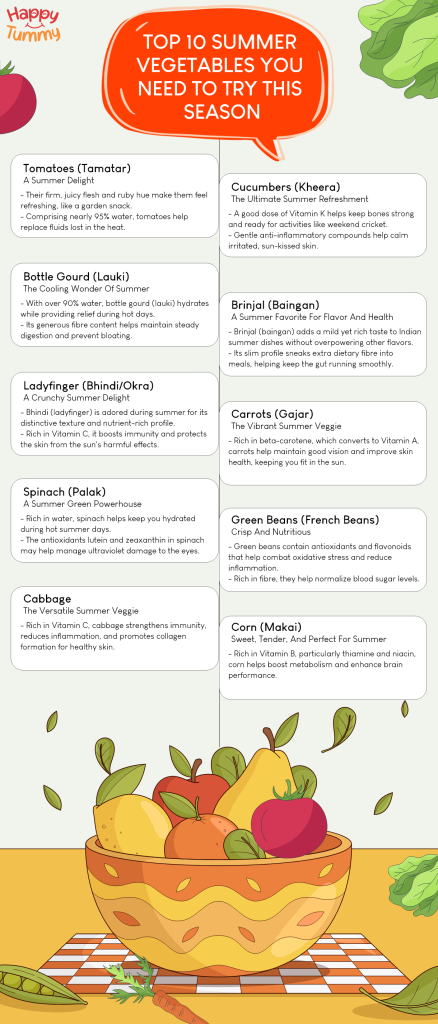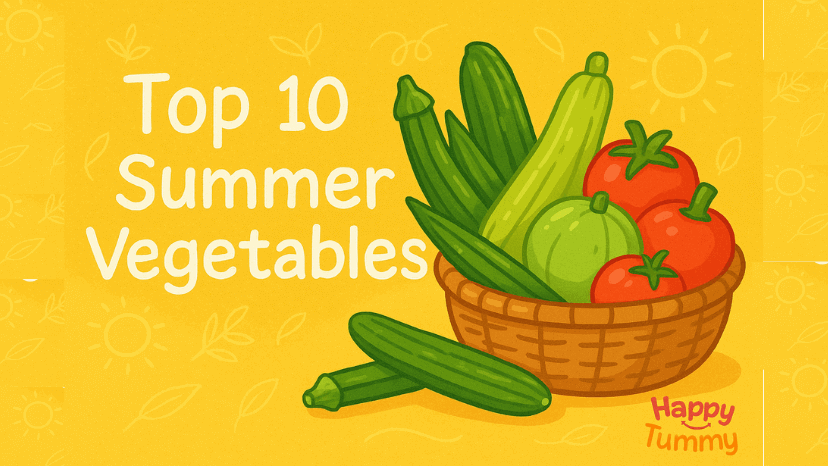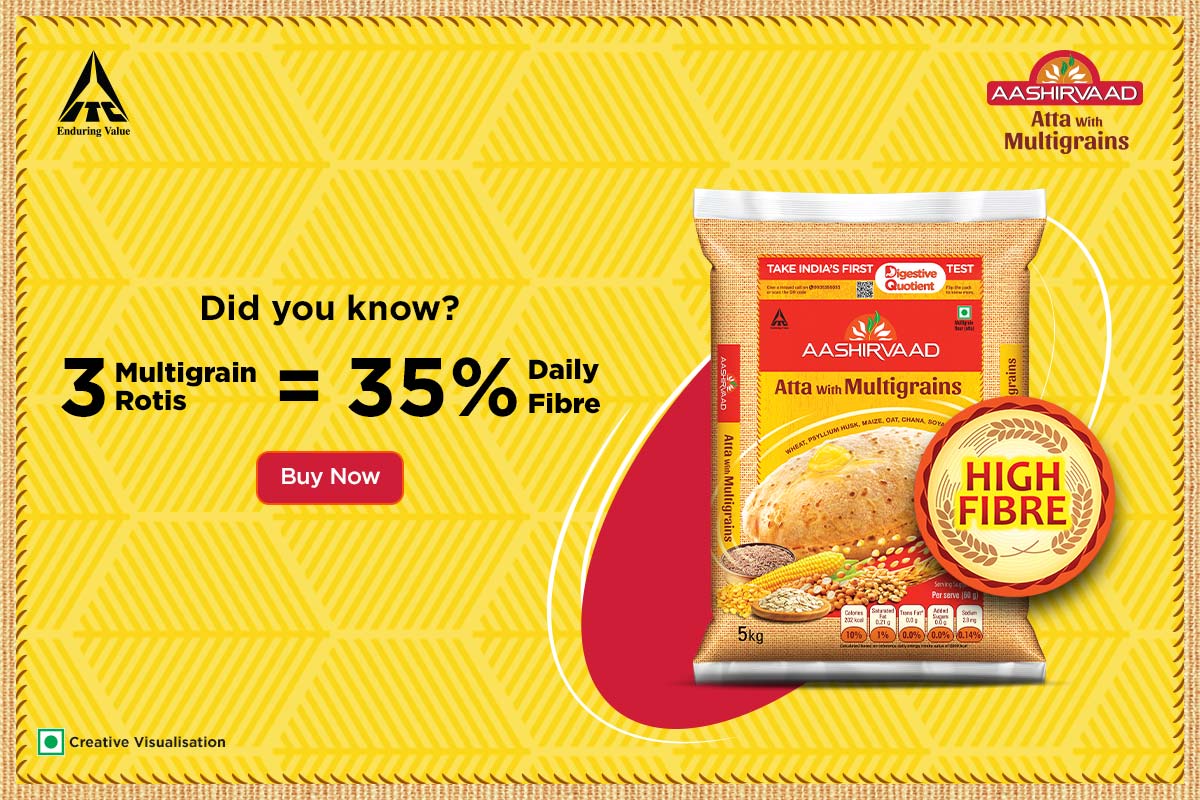Table of Contents
When sunny skies settle in and temperatures climb, something special happens in the kitchen: summer produce bursts onto the scene.
Imagine wandering through a neighbourhood farmers’ market where the air hums with chatter and crates overflow with shiny vegetables.
From sun-ripened tomatoes to snap-fresh cucumbers, summer’s harvest offers more than vibrant colours; it brings a chorus of bright tastes, crunchy sensations, and nourishing goodness to every bite.
Those long, bright days let the garden work overtime, coaxing out flavours and textures that winter veg just can’t touch.
This guide walks you through the stars of the season so every meal nods to the harvest outside; all you need is a large bowl, a sharp knife, and a willing appetite.
Explore this article to know the most effective summer vegetables that have the capacity to make you overcome the unbearable heat and infuse a fresh touch to your dishes.
Daily Vegetable Intake Guidelines (ICMR)
According to the Dietary Guidelines for Indians (ICMR), the recommended daily vegetable intake is as follows:
- Total vegetable consumption: 400 grams per day.
Out of this:
- 100 grams should be from roots and tubers.
- 100 grams should be from green leafy vegetables.
- 200 grams should be from other vegetables.
This balanced approach helps ensure a variety of nutrients from different types of vegetables.
Best Summer Vegetables for a Refreshing Season
When the thermometer climbs, there’s no better way to beat the heat than loading up on crisp, cool summer vegetables.
These colourful produce picks refresh the palate while delivering vitamins and minerals that keep you feeling good on steamy days.
Discover the top summer veggies to incorporate into your dishes, allowing you to savour the season while staying nourished.

1. Tomatoes (Tamatar) – A Summer Delight
Tomatoes do more than dress up summer plates; they also cool you from the inside out. Their firm, juicy flesh and eye-catching ruby hue make every bite feel fresh, almost like a small garden snack.
Because they are made up of nearly 95 per cent water, tomatoes act like nature’s little water balloons, helping to replace fluids you lose when the heat hits.
On top of that watery goodness, they bring a hefty dose of Vitamin C, which can shore up your immune system.
The bright pigments-lycopene in particular-drag free radicals and even some of the sun’s harsher rays out of your skin.
A decent dose of potassium rounds things out by keeping muscles steady and making sure blood pressure doesn’t spike after those long afternoon strolls.[1]
Toss them into a crisp salad, grill them, or stir them into a late-night curry, and you have easy summer comfort that also comes with real health benefits. The following table provides the nutritional composition of 100 grams of ripe tomato:[2]
| Ingredient (100g) | Moisture (g) | Energy (kcal) | Carbs (g) | Fibre (g) | Vitamin C (mg) | Potassium (mg) |
| Tomato ripe | 93.62 | 19.5 | 2.7 | 1.77 | 27.47 | 204 |
2. Cucumbers (Kheera) – The Ultimate Summer Refreshment
When the summer sun hits hard, nothing beats a cool cucumber. With more than 90 per cent water, this humble vegetable works overtime to quench your thirst and prevent you from feeling sluggish.
Additionally, a decent dose of Vitamin K helps keep bones strong and ready for the weekend cricket game, while gentle anti-inflammatory compounds calm irritated, sun-kissed skin.
It’s small stash of antioxidants, including beta-carotene, adds another layer of defence against UV damage.[3]
Eating a cucumber helps in keeping your body hydrated and also serves the purpose of a coolant and cooling down your body during the summer.
Detox water can be prepared using cucumber and mint, and this is effective in flushing all the toxins present in the body, thereby leading to many health advantages.
The low-calorie count and chunky fibre make cucumbers slide easily into salads, raitas, or just sprinkled with salt, leaving you light, satisfied, and ready for the next heat wave.
The following table provides the nutritional composition of 100 grams of cucumber:[4]
| Ingredient (100g) | Moisture (g) | Energy (kcal) | Carbs (g) | Fiber (g) | Vitamin C (mg) | Potassium (mg) |
| Cucumber | 92.96 | 19.8 | 3.48 | 2.14 | 6.11 | 183 |
3. Bottle Gourd (Lauki) – The Cooling Wonder of Summer
Bottle gourd, familiar as lauki, holds an honoured spot on Indian thalis when temperatures rise, because every bite whispers relief from blazing days.
Packed with more than ninety per cent water, this mild-tasting vegetable hydrates as it fills, while its generous fibre content keeps digestion steady and bloating at bay.
The common lauki becomes an ally for skin radiance and immunological defence as it contains necessities like vitamin C, the B crew, and a dash of minerals.
With few calories and bold antioxidants, it detoxes quietly, so individuals on calorie-restricted diets, watchful eaters, and fitness buffs find a friend in the slender green bottle. [5]
Whether sloshed in curry, poured into ice-cold juice, or served with raita, lauki remains light, kind, and perfect for hot afternoons.
The following table provides the nutritional composition of 100 grams of bottle gourd:[6]
| Ingredient (100g) | Moisture (g) | Energy (kcal) | Carbs (g) | Fibre (g) | Vitamin C (mg) | Potassium (mg) |
| Bottle Gourd | 95.17 | 11.0 | 1.68 | 2.12 | 4.33 | 124 |
My Meal Plan test, designed by Aashirvaad Atta, Multigrains, and its highly qualified nutritionists, establishes the amount of fibre intake per day and develops a sufficient food plan that meets the demands.
4. Brinjal (Baingan) – A Summer Favorite for Flavor and Health
Brinjal, known as baingan in Hindi, shines on Indian summer tables because its mild yet rich taste never overpowers other dishes.
Because it cooks down so nicely, the slim vegetable also sneaks extra dietary fibre into meals and keeps the gut running smoothly.
Deep-purple skin contains anthocyanin antioxidants, which gently combat oxidative stress and help alleviate some of the heat that high summer days bring.
With very few calories and a good source of magnesium, manganese, and potassium, baingan helps keep blood pressure steady and won’t upset weight-watchers’ goals. [7]
Whether it’s grilled over the coals, roasted in the oven, or simmered into a tangy curry, baingan is a sunny, healthy star on the plate.
The following table provides the nutritional composition of 100 grams of brinjal:[8]
| Ingredient (100g) | Moisture (g) | Energy (kcal) | Carbs (g) | Fiber (g) | Vitamin C (mg) | Potassium (mg) |
| Brinjal | 89.95 | 27.2 | 3.49 | 3.57 | 1.58 | 247 |
5. Ladyfinger (Bhindi/Okra) – A Crunchy Summer Delight
Bhindi or ladyfinger is the ideal vegetable, which is adored during the summer season because it has a distinctive texture and offers nutrients. Bhindi is a good source of fibre, which can manage constipation, facilitate bowel movement, and normalise blood sugar levels.
It also contains a lot of vitamin C that boosts the defence status and shields the skin against sunshine during the summer seasons.
The abundance of antioxidants, in particular, flavonoids, that bhindi contains will help to fight inflammation and protect the organism against oxidative stress-related harm. [9]
Bhindi is a low-calorie vegetable that is rich in nutrients, making it a perfect vegetable to complement a balanced but healthy diet.
It may be prepared in a number of forms, be it sautéed or stir-fried; it satisfies your diet during summer.
Aashirvaad Atta, along with a panel of experienced dieticians, developed the Digestion Quotient that gives out your digestion score out of 1 to 100.
To discover your Digestive Quotient, run through this short 2-minute quiz.
The following table provides the nutritional composition of 100 grams of ladyfinger:[10]
| Ingredient (100g) | Moisture (g) | Energy (kcal) | Carbs (g) | Fiber (g) | Vitamin C (mg) | Potassium (mg) |
| Ladyfinger | 89.06 | 27.5 | 3.62 | 4.08 | 22.51 | 263 |
6. Carrots (Gajar) – The Vibrant Summer Vegetables
Gajar, or Carrots, are colourful and nutritious in summer dishes.
Water-rich and having the beneficial quality of making you hydrated, they also add a certain amount of sweetness to the food.
Rich in beta-carotene, which converts into Vitamin A, carrots may help maintain good vision and improve the condition of your skin, keeping you fit on sunny days.
They are also an excellent source of fibre, which may aid in digestion and support a healthy immune system.[11] Gajar raw in a crunchy salad, in a smoothie, or cooked in a curry gives a refreshing, healthy fill on a summer’s day.
The following table provides the nutritional composition of 100 grams of carrots:[12]
| Ingredient (100g) | Moisture (g) | Energy (kcal) | Carbs (g) | Fibre (g) | Vitamin C (mg) | Potassium (mg) | Beta Carotene(mcg) |
| Carrots | 87.69 | 33.2 | 5.55 | 4.18 | 6.22 | 273 | 5423 |
7. Spinach (Palak) – A Summer Green Powerhouse Vegetables
Palak or spinach is a rich leafy green that has vitamins A, C, and K, iron, and folate that aid in strengthening the immune system, good skin, and good sight. There is a lot of water in it, too, and this keeps you hydrated. Spinach also consists of antioxidants in the form of lutein and zeaxanthin, which may manage ultraviolet damage to the eyes.[13]
The vegetable is versatile and can be served in a soup, a smoothie, its a salad, or as a side dish in summertime meals, in addition to providing its taste and nutritional value.
Please note that if an individual is on a vitamin K-restricted/ acitrom diet, he or she should avoid consuming green leafy vegetables.
The following table provides the nutritional composition of 100 grams of spinach:[14]
| Ingredient (100g) | Moisture (g) | Energy (kcal) | Carbs (g) | Fibre (g) | Vitamin C (mg) | Potassium (mg) | Vitamin K (mcg) |
| Spinach | 90.31 | 24.4 | 2.05 | 2.38 | 30.28 | 625 | 325 |
8. Green Beans (French Beans) – Crisp and Nutritious Summer Vegetables
The green beans, or French beans, are a high-fibre vegetable that gets along with the digestive system and the rest of the bowel. They are a source of some essential nutrients, such as Vitamin K, which plays a vital role in bone formation, and Vitamin C, which leads to a better immune system and skin.
Green beans have antioxidants as well as flavonoids that help in combating oxidative stress and inflammation. [15] They are also rich in fibre and they normalise blood sugar levels.
You can season green beans in the form of your choice, whether steamed, sautéed, in salads, and curries, and will not leave you listless, hungry, or disoriented with their refreshing, low-calorie addition.
The following table provides the nutritional composition of 100 grams of green beans:[16]
| Ingredient (100g) | Moisture (g) | Energy (kcal) | Carbs (g) | Fiber (g) | Vitamin C (mg) | Potassium (mg) |
| Green beans | 89.14 | 24.4 | 2.68 | 4.38 | 15.81 | 324 |
9. Cabbage (Patta Gobhi) – The Versatile Summer Vegetables
Cabbage or patta gobhi is an all-arounder vegetable that has many health benefits, particularly during the summer months. It is rich in Vitamin C, which strengthens immunity, manages inflammation, and promotes collagen formation to create healthy skin.
Cabbage is also extremely high in fibre, which is beneficial to digestive health and detoxification, an essential consideration in the hot months.[17]
Nutritious and low-calorie, cabbage works to create low-calorie, nutritious dishes such as salads and stir-fries, and therefore is an excellent summer vegetable to get you through summer, keeping you light, calm, and energetic.
Please note that individuals with thyroid dysfunction should be cautious while consuming cruciferous vegetables such as cabbage, cauliflower, etc, as they can lead to thyroid imbalance.
The following table provides the nutritional composition of 100 grams of green Cabbage:[18]
| Ingredient (100g) | Moisture (g) | Energy (kcal) | Carbs (g) | Fiber (g) | Vitamin C (mg) | Potassium (mg) |
| Cabbage | 89.53 | 21.51 | 2.79 | 2.98 | 40.76 | 292 |
10. Corn (Makai) – Sweet, Tender, and Perfect for Summer Vegetables
Makai, or corn, is a highly nourishing summer vegetable full of antioxidants and fibre. It contributes to the normal digestive compliance and offers a consistent energy supply during the day.
Corn also contains vitamin B, especially thiamine and niacin, which are helpful in raising the rate of metabolism and in enhancing the performance of the brain. Its high antioxidant contents help eye health, including the lutein and zeaxanthin that protect the UV damage.[90]
Sweet and nutritious, makai finds its use in salads and soups as a sweet taste that makes meals of this summer healthier.
The following table provides the nutritional composition of 100 grams of corn:[20]
| Ingredient (100g) | Moisture (g) | Energy (kcal) | Carbs (g) | Fiber (g) | Vitamin C (mg) | Potassium (mg) |
| Corn | 75.44 | 73.2 | 11.66 | 6.09 | 19.32 | 258 |
The Bottom Line
Summer vegetables are not just a delight to the taste buds but are also a source of health. They are full of essential nutrients, antioxidants, and water content that helps keep the body hydrated, enhances the digestive response, and enhances immunity, hence ideal in this hot summer.
Such seasonable vegetables as tomatoes, cucumbers, and carrots will give you a cool method of taking care of your overall health and liven up your plate with bright colours.
As you add different types of summer vegetables, you will be certain of encountering a wide range of vitamins and minerals that will make you stay active and energised all through.
Eating well with a balanced diet, high in fibre, vitamins, and minerals, is the key to health and the prevention of seasonal sickness.
A healthy, balanced diet is not only good physically, but in helps you feel good and cheerful. In case you do have any particular diet-related issues or medical conditions, consult a medical practitioner and obtain specific instructions.
Frequently Asked Questions
It is effortless to increase the number of vegetables by introducing them into your dishes in different forms.
Consider putting more vegetables on top of salads, soup, stir-fry, or even smoothies. You may also replace the processed snacks with raw vegetables such as carrot sticks or sliced cucumbers.
The out-of-season vegetables, as a rule, are less flavorful, less fresh, and more expensive compared to the seasonal vegetables.
They are cultivated in large quantities when they are in season, hence they are of more nutritional value and contain low amounts of preservatives.
Consuming local vegetables will involve buying those that are in season, and also ensure that you have a reduced carbon footprint.
Absolutely! Lots of vegetables found in the summer can be easily cultivated in a home garden, including tomatoes, cucumbers, and peppers, to name a few, and even in a small garden, such as a balcony or terrace.
Take proper care and watering, complemented with the beneficial presence of sunlight, and you will have fresh homegrown vegetables throughout the season.
















